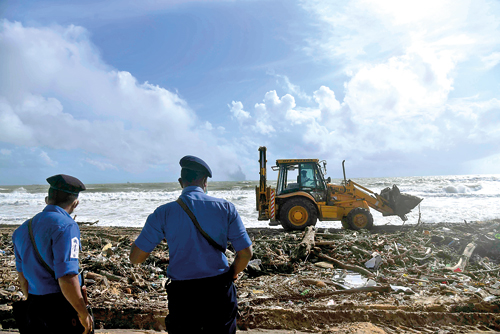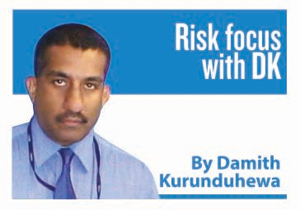X-Press Pearl: Six emergency response stimuli prompted by Colombo maritime disaster
View(s):
Debris from the ill-fated ship being cleared at a beach in Sri Lanka's west coast
“What matters most is the ‘READINESS IN REALITY AT ANY HOUR” was a punch-line I encompassed in my guest write-up related to Marine Emergency Response in June 2018 for “8 BELLS” – a magazine for Sri Lankan merchant vessel commanders around the globe.
“The ocean surface does not leave trails” goes a universal saying. While it may be so in generic conditions – and not so in certain conditions, the recent marine disaster (chemical leak + onboard fire + response deficit + destruction of cargo + sinking of the ship + marine bio and eco pollution + logistics conveyance disruption + recovery cost + compensations + overall economic dip) in and around Colombo seas surely left voluminous Emergency Response (ER) learning trails for us to be reminded of once more.
On this specific maritime disaster, there seems to be diverse expressions and counter-expressions about the response efficiency. The detection of the chemical leak, reporting of the leak, anchorage sanction, efforts taken for leak sealing or dilution, detection of the incipient flickers onboard, the aptness of extinguishing medium, immediate firefighting effort, flame-spread containing effort, resources marshalling effort, cargo salvage effort, crew rescue, towage effort, ambiance toxicity mitigation effort and so on (executed under volatile oceanic weather fluctuations) are being intensely debated in numerous maritime, commercial, logistic and political realms.
Despite the claims and counter-claims rolling in the grinder, the disastrous end-result of the episode grimly stands next to zero.
When our ER fundamentals – clarity, capacity, coordination, capabilities, competence and cohesiveness (6Cs) are debatable at the global maritime, insurance and venture investment domains, we also place our preferred reputational theme – “Colombo Sea Port as one of the Asia’s premier maritime logistics hubs” – in the line of uncertainty – both professionally and commercially.
The ‘bang’ created by the ‘MV X-Press Pearl’ is enough shockwave for even someone less concerned to be jolted-out from a deep slumber to comprehend harsh realities of life, work, business and the world at large.
The hell usually breaks loose when we least expect it – and that is an enigmatically bizarre phenomenon. We can be corporate, institutional, marine, aviation, military or state – every sector and each entity needs a fresh brace-up to face-up, not if, but WHEN an emergency happens out of the blue at our respective doorsteps.
May be we already have plans rated as ‘good’, but also we need to be enlightened to the fact that “Good is not good where BEST is expected”.
In Retrospect:
Notwithstanding “One in a Million Case” perspective by the sundry, since 2005 through this risk educational column, I have intermittently been emphasizing the value of Emergency Readiness and the “Price of Unpreparedness and Under-Preparedness”, by case-pointing diverse real-life emergencies and learnings as they befell, including the following.
- Grenfell Tower Inferno – UK
- Taj Hotel Hostage Fiasco – India
- Tham Luang Cave Rescue Mission – Thailand
- BLACKWATER Shooting – Iraq
- Unilever Fire Disaster – Sri Lanka
- Kosgama Military Arsenal Explosions – Sri Lanka
- 2016 Flash Floods Calamity – Sri Lanka
- Enrique Concert Invasion – Sri Lanka
- Easter Bombing Disaster – Sri Lanka
History repeats until we do it right. Thus, let’s now focus on six critical ER facets that we ought to recap, as prompted by the trails left by the ‘MV X-Press Pearl’ maritime disaster.
Stimulus 1: Emergency Prevention:
In a pertinent sense, every country, every entity, every institute, every operation, each critical process of actions – business and otherwise – needs to devise emergency “prevention” plans and practice. Being armed with a comprehensive Emergency Response Readiness does not warrant us to engage in routine maneuvers casually, without taking an objective effort to ensure contingencies.
On the contrary, an entity can be rated efficient in the routine practices when they were not compelled to activate their Emergency Response Plan (ERP) even once to date. These are entities that objectively prevent (potential) major emergencies in their everyday actions. Those entities well manage mishaps at its infancy by timely intervention. And then there are other unconcerned (naively vulnerable) entities that never had an emergency thanks to sheer “luck factor”. That luck might also be professed as efficiency, which is only illusionary.
 Stimulus 2: Response Design:
Stimulus 2: Response Design:
The age-old maxim “Hope for the best – yet plan for the worst” is a human wisdom attained through bitter experiences. Thus, the blueprinting of the ERP on the right platform is an essential measure.
In the case of the ER, the wayward grey-areas which exist in terms of “execution authority” is a killer of time and efficiency. Thus, in the case of a country, the right kind of legislation – and in the case of an institute the right kind of organisational authority must be set in place, in advance.
Empowered by clear-cut authorisation – the ER concepts, risk analysis, probability and impact matrixes, policies, objectives, budgets, structures, command flows, procedures, protocols, timelines, legal aspects, strategic and action manuals and so on should be formulated under this segment.
“Plans are nothing, but planning is everything” – so stated former US President, General Dwight David Eisenhower – and that functional acumen underscores the criticality of this phase.
Stimulus 3: Response Resourcing:
What if we see in the snowballing flames, and soon we find-out that we do not possess the precise medium to fight the fire?
No emergency response can be started and rolled-out till the very end successfully without the availability of the right and adequate resources at the action bay and in the pipeline flow.
The resourcing requires right people, preferably headhunted for proven ER efficiencies. It includes blueprint thinkers, strategic planners, plan executioners, action responders, logistic coordinators, communicators, medical staff, advisory experts and so on.
Then comes the mustering of response logistics such as equipment, tools, material, communication and support services on immediate, intermediate and final stages of the emergency, both on local and overseas resource platforms, as per the calculated escalation of gravity.
Resourcing ER funds in relation to sourcing and flash-funding during the actual distress is another critical element to be planned-out at this stage.
Stimulus 4: Action Simulating
“Risk comes from not knowing what we are doing” goes a saying.
That is why ER education for the strategic strata and ER orientation for operational strata is required. Then, the response teams must be well-trained on calendared schedules, followed with near-real life simulations modelled at moderate, worse and ultra-worse case mockups with rightly phased-out response heat-mapping.
The simulations should be appraised with immediate and eventual feedbacks and management reviews of the negatives – neutrals – and positives for further improvements. And this cyclic manifestation shall continue to exist in the organisational calendar.
Stimulus 5: Response in Real:
“BANG” goes the alarm bells, and it’s now or never time to get the ball-rolling while on the run…!!
The above four stages are now TESTED on the reality, sometimes breeding life-and-death scenarios for likely victims and responders alike.
That is why “the readiness on any day at any hour” is the mantra for both safety and success. The right kind of ER flow will swiftly dispatch the immediate response teams, rescue teams, external action agencies and muster salvage teams and re-claim (consolidating) crews.
The ER response is flexible for situational decisions and also rational deviation from the ER blueprint based on ground-realities and unforeseen eventualities while keeping the ER objectives intact.
Stimulus 6: Recovery
Once the ER segment meets its success objectives, it then is the time to activate the Disaster Recovery (DR) phase. It’s a seamless transition from high octane ER action to rather moderate DR motion.
The DR phase involves restoration and repair, media management, brand safeguards, damage assessment, inventory loss auditing, insurance, incident investigation, recompense and so on. It also involves initiating post-traumatic stress disorder (PTSD) treatments for the survivors of the emergency – and also for the front-line action terms that underwent the response compressions.
A swiftly driven DR effort paves the way for rapid activation of BCP (Business Continuity Plan) in applicable settings with the objective of reaching BAU (Business As Usual) status at the earliest.
As we can see, it is a complex groundwork from the time of ER conceptualisation up to eventual consolidation. That is why preparation in advance is highlighted as “when disaster strikes, time to prepare has passed”.
“We don’t drown by falling in the water; we drown by staying there” reverberates the wisdom shared by Edwin Louis Cole.
It’s time to get ready to swim right BEFORE THE FALL !!
(The author is a foremost enterprise risks & ERP / BCP specialist and a corporate risk trainer who serves as the CEO of Strategic Risk Solutions. He is also a guest columnist for the Sunday Times since 2005. He can be reached via email on solutions@sltnet.lk or
via web www.solutions.lk)


